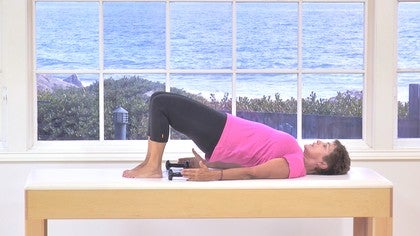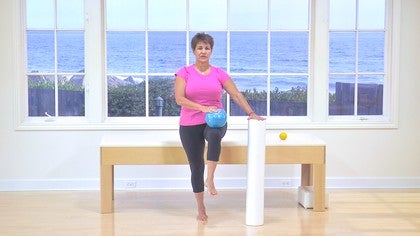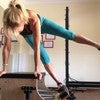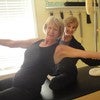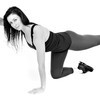Description
You can watch Beginner Series 1 to learn more important Pilates fundamentals.
About This Video
Transcript
Read Full Transcript
This is another fundamental workout. This is our second workout and kind of our beginner series that we started with a fundamental connections where you learned how to activate appropriately while turning off maybe some of your extrinsic musculature. In this particular workout you'll do well to have a ball and you'll notice that this ball is not pumped up really, really big because we're going to want it to be just a little bit squishy and we have to hand weights. We'll start this workout lying on our back, recognizing the neutral position of your pelvis and recognizing your neutral position of your neck. Some of you may be propped up and some of you may not be. Again, if the position of your upper back and shoulders is like this and your head tends to go back like this, then you definitely need a prop and you may want to visit the tutorial on where's your head position.
So we just want to create a successful position to start with. So from here, big, big inhale, and then big, big exhale, sinking your abdomen down has if there were a sandbag right on your belly, and two more times. Inhale big, and then exhale, release.
One inhale, one exhale. Melts the abdomen. Soft, neck and throat. Leg lowers down.
And then bend the knee in right leg out. Long, double check. Melt the face, scoop in the belly, melt the belly. Inhale, prepare. Exhale, raise to the level of the right knee and that would be my left knee. Inhale and exhale. Raise it to the level of your left knee and then lower down. One more time. Big Inhale. Exhale, soft neck check-in. Put Your own hand on your collar bones. Maybe put your hand behind your neck, always self check yourself.
Even if I don't suggest it, you can certainly do it and then that knee comes in. Staying with the lower body right here. Take an inhale. Exhale, sink the sandbag down. Invite the tailbone to come into a curl. The buttocks will start to work, but it doesn't work first to get the curl and then unroll yourself down. What works first, inhale, exhale. Sink the abdomen.
Use Your abdominals to curl the pubic bone closer to your chest. Start to peel your buttocks up just a Smidge, just a Smidge, and then roll it all the way back down. One more. Inhale, one more exhale, melt. Curl. Check in with the head and chest. Self-Monitor your neck, that your head didn't look up as your tail bone curls up and then slowly, slowly lower that down. Let's go to the neck. Let's take the front of the neck and make it longer by letting your eyes and your nose and your Chin look up over your head and then your eyes and your nose and your Chin drop down as if your eyes were going to look towards your knees.
Inhale, exhale. This takes a couple of times to get the access of motion to be where you want it to be. The ears lengthen the neck. Exhale, Chin and nose and eyes and forehead. Notice I haven't even lift my head up off the table yet. I'm just doing the skull rotating on the top of my cervical access. Then now I'm going to just lift my head.
Notice my trunk is not curling. It's only my head. Join me again. Inhale, go back. Exhale, eyes and nose and chin, and then for head lift I add a smile. It does feel different. I promise you do it. You send me a note if it feels different and then come back. Often Times this can happen. Inhale, exhale, the hurdlers and your goes like this and you're trying to use some other marshals that's real attractive. And then take that down. And then last time correctly, forehead, nose, chin, I lift and now and only now can I add a trunk curl and then roll self down.
If that is too hard for you to trunk curl, you'll put both of your hands behind your head. You lengthen your skull, your eyes look between your knee and you kind of rest in your hands as you curl the trunk. And then you take your hands away to challenge. And then you put your hands up [inaudible] support. And then you unroll yourself all the way back down.
Very good. So now we'll let it that get organized and we'll go back to challenge ourself with our weights. So with my head and my chest and my trunk, all in this nice position here, take an inhale. Exhale. Kerplunk those shoulders down. That's my professional word for the day. Arms are strong. Don't, don't get lazy in the elbows here.
So straighten the elbows all the way out. Tighten up your triceps. Inhale, arms back. Exhale, they return five times. Relax the head and chest. Exhale and return. Now you have to self monitor with your brain because your arms are occupied with the weights so you can't feel with your hands behind your neck, but you can kind of feel by the position and then return. And then one more time, arms back. And one more time. Arms Return.
Let's take the left leg up and then three times just with the left leg by itself and the right arm by itself. Inhale, exhale. Inhale. I'm just exaggerating the breath so you can hear it. And then one more time reach and then one more time return. And then those lower down, right leg lifts, left arm moves, go. Inhale, exhale, melt. Inhale, exhale, melt.
And then last time, inhale and exhale, melt. That foot comes down. I want you to put your legs all the way down on the mat as if you were standing on the floor. I want you to make a note what happened to your head and your chest and your trunk if you were able to stay. And not do any lurching. Then you'll keep your legs straight.
If when your legs went straight, your body did this, then you need to bend your knees in, check in with the abdomen, melt your face down and don't disturb it and just have one leg go down. Okay, so now we're going to challenge a little bit differently. I'm gonna take my right arm off at a diagonal and my left leg out at a diagonal and just hold it here. Hold it here and hold it here some more, and then bring everything back. We're going to do that again. This is tricky.
My right arm is back at a diagonal to challenge rotation of my upper trunk. My left leg is up and out at a diagonal to challenge my pelvis rotation. Going to hold this and hold it strong. Checking in that my neck and my face and my back aren't changing. Everything comes back and then lower yourself down.
Switch legs, diagonal, the left arm, diagonal, the right leg hold, hold and hold, and then everything comes back. Inhale, exhale, melt diagonal. The left arm, diagonal, the right leg. Give your pelvic floor a little invitation to help the core, and then everything comes back. You can repeat that with one knee bent and the other leg straight. Or you can join me with two straight legs and the arms in the air. I want you to notice my pelvis right now in my thighs that if I squeeze my buttocks really tightly, notice the position it puts my pelvis and my thighs in bulging thighs.
Don't want that. So your glutes actually need to relax right here as I lengthen the abdomen and relax the neck and the face, if you will. So now this exercise becomes a little bit tougher. Two straight legs, one leg lifts up, lowers down. It's a sequence up, out, in, down, up, out, in and down. One more time, up, out, in and down, right leg up and out, in and down. You want to watch that. You don't take that leg away, far out because then it'll rotate and put a force on the spine.
So two more up, out, in and down. Less time, up and out and in and down. If that was too hard, the next time you do it, you can put the weight on your belly and have your arms down by your side and you can do it like this. It's never hurts to go backwards. It's still a good exercise. No Watch. Bend the knee, knee out, knee in, knee down. I can use my arms a little bit, but not so much that I change the integrity of my neck and my lumbar curve. It allows me just a little bit more freedom with my arm if I need to do this. Self checking up out in and down.
One more time. Up and out and in and down and those exercises become single leg circles, single leg stretch, double leg stretch, everything like that. So now I'm going to take my arm, both of my arms down by my side. Belly sinks in, lift one leg up, no lurching in the head, in the face. Belly scoops in other leg lifts. Hold right here.
Arms down by your side or by here on on your torso. Sometimes again, if you put your arms by your side too much, it kind of makes the position change and your torso. And then we're gonna do a toe tap. But I'm not gonna tap my toe because it'll change the position of my neck. So I'm only gonna tap the distance that I can maintain the integrity of my voice, of my neck and of my shoulders. 50 more. Just kidding. One more.
That joke will get old and then the legs come down. Also now as a fundamental exercise back into the curl of the tailbone up. Take your time with me here. Lift your buttocks. Check in with the shoulders in the neck. And now we start to lift the buttocks a little bit higher.
Lengthening out the front of the hips. That might have been a little aggravated by lifting your legs up off the ground. Now Watch here. When I lie down, when I lie my spine down, I'm not gonna mess with my face and my neck. I'm just gonna lie right between my shoulder blades down and I'm going to take my time to link then my spine. I think that should be a tee shirt. Take the time to lengthen your spine.
Don't be in a hurry. Take an inhale again. Exhale, do the sinking of the sandbag. Do the curling. Check in with the neck. Check in. Now as I start to lift up, this action has hip extension, so my glutes will kick in. They will be working. My pelvis will be as high as my thighs and now I stay here for two breaths. Inhale, exhale, inhale, exhale.
Take the time. Lengthen that spine. Pause. Face, neck. I had to regroup there. I was starting to go back with my head and then roll yourself slowly, but it's connection all the way down, all the way down. Third Time's a charm. Last one. Inhale, big exhale, sandbag, sturdy neck curl, tailbone. Come on up. Pause, take time, but it starts to come in now.
Abdomen stays neck is not invited to the party. Curl, curl, curl, big. Inhale, exhale. The collarbones broaden. That kind of helps the face rest back. Take time, articulate down. Most people are kind of tight right at that t 12 l one but don't change the integrity of the shoulders or the neck to get that part down. Just repeat it, curling it down. Excuse me.
Uncurling it all the way down, all the way down. Who does a good exercise? Sometimes it just works really well. So now as we ill that fundamental, we're going to come up into one more bridge. I know I said last time, but now we're going to add a leg lift. So it's a different exercise. So I get to duo, sink in the belly, curl the tailbone, roll on up.
Watch the integrity of the neck. Make sure your skull is long. Arms can be down at your side. Now you can press your arms down, you can even karate chop your arms down. Sometimes in this bread position, watch if people's palms turned down and their forearms and elbows are tight. Have you seen yourself do a bridge like this where you're trying to push up but your shoulders don't allow it? So we have to stop the exercise and change the mission. Check in karate chop here. Instead of the palms down.
Maybe it's just your forms that are tight or come to the Texas, the six shooter arms here. So we're going to curl and lift so you can press your arms to help you. I'm fine with that, but you can't press your arms so much that it messes with the neck. Okay, so that's the difference. You can use a strategy, a good one if it doesn't change your neck position. Inhale here. Exhale. Think about lifting your left leg off the ground. You don't have to lift it, but just think about lifting it.
Feel the buildup of work in your right buttocks, feel it and then stop. Pick up your right leg, but you don't have to. That's the key. You don't have to. But as you think about it right here, the left leg starts working and then the right leg comes back one more time. Think about lifting the left leg and then like magic you can, and then you put that leg down and then you think about lifting the right leg and then you can and the left buttocks is engaged. And that leg comes down and still your face is soft, your brain is resting down. You take that time to uncurl the spine all the way down to the mat.
Nice fundamental workout of your trunk. The next exercise, we will challenge the trunk and extension inflection and we'll use our little ball. So I'm going to come up to sitting and I'm going to put this ball. It's kind of an imperfect position. It basically has to be kind of between your shoulder blades. It has to be high enough here because what I'm looking for now is I'm looking for this abdominal region here to kind of lengthen. So you'll see here it's actually too low because then my head will just go back and that's not good. So I'm going to support my head with my hand watch.
I'm going to crawl my body down, sorry for that sound. But now the ball is in a good place. So now as I lengthen my chest, you'll notice that I'm not letting my head go as if I were holding something under my chin. I'm going to start to lengthen my chest and only when I lengthen my chest all the way can I then let my head go. So can you see that if the ball were much higher, it would actually make my head fall back and sheer back instead of allowing the lengthening up through my sternum.
So feel this as an opening of the chest and not as an arching of the low back. You'll notice here that my pelvis is still very neutral. I'm trying to this passive feeling in my chest to go back so that when I turn on my belly and I do the exercise, Swan, can you see my hands like this? And if I turned over now and was in Swan, I'd be pulling my chest bone forward. So the purpose of the bowl here first is to give you a passive feeling in your chest.
And then the next reason for the ball here is to give me a nice challenge for my deep neck and my trunk. Watch here, one here and behind the head. Inhale. Exhale, chin, nose and eyes. We've already done this exercise. It comes forward. Inhale, fill the back ribs, exhale my trunk curls and my head joins me. I roll myself back to level. And then I take my spine on this journey backwards. And then Chin nose, head curl.
And then my trunk brings my head along for the ride. One more time. Lengthen back, head back. Inhale, big. Exhale, Chin nose, head curl. Now I'm going to try it without my hand helping me pay SPEC. Pay Special attention to my trunk is not moving. Rolling back. I'm not gonna let my head go knock and let my head go. Not gonna let my head go, not gonna let my head go. Ah, and then now forehead, nose, Chin.
This is a lot of work. And then curl. If you can not do it without straining, then you need to put your hand back here. Doing it in a non optimal fashion, like this is not worth it. Okay. We've learned how to do this center bridge, so we're going to learn how to do it here again. So forehead, nose, Chin curls, trunk curls, big time connection in the trunk to help the neck be supported in this lift. Very good. Alrighty. We'll come up off of there in roll to your side.
So the challenge in sideline now is where does the head go? I'm going to get one prop really quick. It's important in sideline, we didn't talk about these a lot during the tutorial,
And then I actually think I need one more little wedge here because really the setup, it's really an important part of the exercise. So I think that here is pretty good. And with this little pillow here that has these corners, I can kind of move my head a little bit and kind of get it where it needs to be. Okay. So again, if the camera were above me looking down, you would want your head to be over the center of your chest and of course the center of your chest to be over your pelvis. So first what I want to do is I'm going to monitor my neck with my right hand and my knees are just going to be bent in. So again, I the focus here in this fundamental, when I lift my leg, yes it's a leg exercise, but it's also um, a core exercise if you will, because it has a pay attention to what's happening.
Your neck here, I'm going to check the front of my chest, checked my abdomen, be sure nothing is overworking this way. And then when I really pay attention to the integrity of my neck, I can feel my hip muscles live up a little bit. And then I'm going to lower it down. So do this about five times. Inhale, exhale, lift and lower. So the only focus that I want you to have right now is that your head is melting down. So now your brain if you will, is falling to the left side of your skull. We know that really can't happen, but I just really don't want you to pull up like this and pull up like this and so that you get all sort of mishmash of information. Now I really feel the side of my leg, I really feel the integrity of my core here and I feel how I'm not working here.
I said five or eight. Anyway, I'm on probably 90 or something and then we'll rest down. So now from here I'm going to take my right leg out long. So now I have a long lever arm and as I get along lever arm here and I stretch out, I feel Whoa, I want to stretch and then I want to go into that extension pattern or some people will go into a tucked bottom pattern and want to change here. Both those two extremes, the extension pattern and the tuft pattern don't allow for the integrity of the core here and of the not working.
Just so you can see that in this imperfect system, we actually have to be in constant check. Hopefully you can actually see that. That's actually a little bit better for me. So now my right leg is out long, my abdominals are pulled in, my neck is soft, and then I'm going to lift up and down and then of course this becomes the leg series in our full Pilati repertoire. But what it is now, it's an invitation again to your body as the classroom taking particular attention to what's happening to the neck and the trunk. As I raise in lower my right leg one more time, raise it up and hold no tiny circles. Inhaling and exhaling melting your head. Hopefully you, you may have just seen that because I actually felt like I was starting to lift my head up, but when I exhaled I kind of melted myself down. I'll reverse the direction of the circle and my foot just in a position.
It's not pointed or flexed really because right now when this fundamental awareness, I'm just paying careful attention to what's happening to my neck and I'm going to bring that knee in and rest it down. Am taking my arm down by my side and just take it up in the air. Inhale and take it down by my side. Exhale, I'm going to take my other hand and put it up here in my neck so that when I raise this hand up, it's not my networking. If my neck where to work, maybe I'll just raise my hand to here. Inhale and exhale one more time and then come down. We're going to go to the right side, but in between there we're going to stop on our back. I like to do this as a little transition in the fundamental workout and it looks like this. It gets us ready for side bending, so I'm going to take my left arm up over my head and my right hand is going to go to my pelvis and I'm going to side bend my body to the right and then exhale, bring it back. So gravity isn't really challenging me.
Say if I was doing spine stretch side or or side bending on the short box, I'm going to inhale over breathing into these ribs and exhaling return one more time. Inhale, straighten this arm level out the pelvis, melt the neck and the head and then bring it all the way back, right arm up. If when I bring that arm up over my head, it does a little special invitation to the ribs. We don't want that. So maybe for you the arm doesn't go all the way over the head. Maybe it just comes to here and then exhale back two more times.
You can have a wide base of support for your feet here. Inhaling and then exhaling is this is a frontal plane and then one more time side bending to the left and then exhaling
Real important here, I'm gonna Monitor the position of my neck and chest, not overworking. I'm just going to lift my left leg up off the ground. Incidentally, I can press my right leg down simultaneously as my left leg lifts and I can actually feel both those hip muscles working in the same area. Engaged my abdomen check-in that my neck is not overworking. I'm not trying to fight it by lifting up or fight it by changing any position. I'm going to lower it down. I'll lift this leg about five times here, so up and down and then up and down.
The head is resting on the pillow as I lift up and down two more times, lift and lower and then last time lift and lower. Now I make that lever arm longer and I stretch my leg out to the level of my pelvis. You'll want to be careful here that you don't start with the leg down because that can sometimes drag the torso, especially if somebody has larger hips. You want to be sure that the leg starts at level here. You could even put a little boxer or some rolled towels underneath the foot if you had to. I'm going to lift the leg and lower the leg.
So typically we like to say here that this is a leg exercise. We don't want to lift and do this momentum thing because then you'll see there's no integrity. So I'm going to rest my head in my skull. I can lift my neck, pull my belly back, check in that my back and my waistline on overworking, and then my leg lifts up and down. We'll do this 10 times, five more for melt your head down into the pillow. Don't let your neck do the work of your leg. Three and two and one lift. Hold.
And now circle this leg. You can just hover this arm. You can put it down in front of you, but don't let it take over for the lock check-in and reverse the direction and then let that leg rest down. We'll switch now to the quadrupedal position. I'm gonna move my props out of the way in the quadro position. If your wrists bother you, you can move forward to the edge of the table or the Cadillac that you're on.
You could also put a wedge or something underneath your hands. You want to maintain the integrity here of the crown of the head and the bridge of the nose and the chin, and now in this position and this fundamental head position, we're going to repeat some of those same exercises. Tailbone drops, pubic bone curls, and I lengthened my low back and then I take that journey in the opposite direction and return to neutral again. Inhale, exhale. The belly pulls in, the tailbone drops, and I curl from here. Hold this, take both of your hands and pull them towards your knees and you'll feel an amazing connection between your arms and your core and then let the tailbone go and let the buttocks go into extension. Notice that I'm not sagging way down like this.
All I've done is I've taken my tailbone behind me to lengthen out the front of the abdomen, shorten the back, which is extension, and then I drop the tailbone, lengthen the back, shorten the front, which is fluxion, and then I come to level holding yourself here. Regroup, check in with your trunk, check in with your pubic bone. Make sure everything is neutral. Check in with the integrity of your neck that it's not shortened nor hanging, but that everything is in align. Your forehead, the bridge, or your nose, your Chin here. Now we're going to do the journey from the top. So I lengthen out my skull, my forehead, my nose, and my chin. Start to look down. My ribs start to curl.
I come into flection from the top and then I lengthen myself back out. Notice that I'm not rushing right into the arch and tuck or the cat cow. I'm taking my time to take each section piece by piece. Not Easy to do. Now we're going to take the whole journey from the bottom.
Tailbone curls low back, starts to round. Head doesn't drop yet the ribs start to flex, then the head cannot and I can look at my knees. Then I'm going to come out the way I started. So I'm gonna let my tail bone go and then the chest is the last piece and now I am going into extension as if I'm over that ball that was underneath my chest. I'm not just sticking my neck up like this, but I'm letting the chest get longer and now I'm going to go back into flection from my head. This time. Chin nose for head, cervical spine, chest, low back, tailbone.
Now I'm going to challenge this. You Ready? Take an inhale and you're going to challenge it to holding that flexed posture. Lift the knees up off of the Mat, and then slowly lower down. Inhale again. Exhale, pull your belly in deep. Invite those knees up. Hold, hold. You should be glancing towards your knees. Hold and then lower yourself down. One more time. Inhale, exhale. Belly pulls in. Trunk is inflection. We curl and we lift. Hold five, hold four, hold three as if you're holding something underneath the chin, two and one, and then slowly lower yourself down and let the knees go. Let the toes go.
Excuse me. From here, take an inhale. As you exhale, rock back on your hips without changing the shape of your spine and then bring yourself forward. Inhale, rock back. Exhale, come forward one more time. Here's what it's not rock back.
That's what it's not. Skull lengthen. Rigid. The nose, deep black, rock back. Hold yourself here. Breathe two times. Inhale. Exhale. Should be ease of breath without extraneous movement in your neck. And then one more time and bring yourself back to Quadro pad.
Now we are going to take a little exercise here where you pick your one foot up and rotate your torso and look at that foot and then take that foot to the other side and look at it. Inhale,
Inhale to the left. Exhale center. Inhale to the right. Exhale center. Bring yourself back.
More stability. Loading the civility system, right leg out.
Other side, left leg square off that pelvis
My right Shin is pressing down like mad boy. My next year wants to extend right now. It wants to go into an old strategy, but I'm not going to let it and then I'm going to bring that down a little bit quicker. Now go. Inhale, exhale, inhale, don't change anything. Exhale. One more time. Inhale straight knee, straight elbow. Exhale. Last time. Inhale, last time. Exhale and sit yourself back.
Key Connections: Mat Fundamentals
Comments
You need to be a subscriber to post a comment.
Please Log In or Create an Account to start your free trial.
